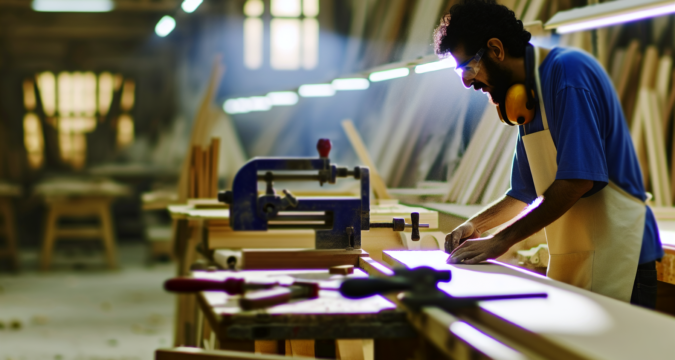
Workshop injuries result in thousands of emergency room visits every year. While some are relatively minor, severe trauma can lead to permanent disability and loss of livelihood. This article provides guidance on implementing rigorous safety programs in professional woodworking workshops to prevent injuries.
| Key Takeaways |
|---|
| Essential Safety Gear and Equipment |
| – Impact-resistant safety glasses and face shields – Hearing protection like earmuffs – Respirators to prevent wood dust inhalation – Cut-resistant gloves – Steel-toe boots |
| Safe Workshop Layout and Design |
| – Wide work zones – Proper lighting – Ventilation systems – Dedicated storage areas – Clearly marked danger zones |
| Strict Enforcement of Safety Rules |
| – Mandatory PPE – Machine certification requirements – Illustrated safety instructions – Regular inspections and training |
| Culture of Safety |
| – Management leads by example – Incentives for safety milestones – Empower reporting concerns – Review near-misses – Celebrate safety records |
Essential Safety Gear and Equipment
Equipping staff properly minimizes risk when operating hazardous machinery or handling dangerous materials. Below are key forms of personal protective equipment (PPE) and safety features on tools and equipment:
PPE Essentials
- Impact-resistant safety glasses and full face shields guard eyes from flying debris
- Hearing protection like earmuffs blocks noise during extended machinery use
- Filtering facepiece respirators prevent fine wood dust inhalation
- Cut-resistant gloves shield hands performing intricate cutting
- Steel-toe boots minimize foot injuries from dropped stock
Tool and Equipment Safety
- Blade guards, power switches, and emergency stop buttons safeguard table saw operation
- Ensure sticky machine power buttons prevent accidental startup
- Confirm tools feature thermal overload protection
Frequent inspection and maintenance ensures safety mechanisms function properly. Replace damaged PPE immediately.
Safe Workshop Layout and Design
A well-planned workshop layout minimizes safety risks:
- Wide work zones prevent crowding and allow safe material transport
- Position lighting to illuminate stock inspection and hazardous areas
- Ventilation systems circulate fresh air and filter fine particulates
- Designate lumber, finishing, and offcut storage areas distant from machinery
- Clearly demarcate and separate danger zones for each tool
- Craft efficient workflows to reduce unnecessary movement
For example, position the table saw centrally for easy infeed and outfeed. Locate sanders separately near dedicated dust collection equipment.
Strict Enforcement of Comprehensive Safety Rules
Consistently enforcing detailed safety protocols protects against injuries, worksite damage, and lost profits:
Safe Tool Handling
- Mandate approved safety glasses, ear plugs, and protective footwear during equipment operation
- Require machine-specific certification prior to use
- Produce illustrated step-by-step instructions for risky tool procedures
For instance, confirm staff adherence to specific table saw guidelines, like employing push sticks with narrow ripping.
Regular Inspections and Training
- Perform weekly safety reviews of all workshop tools, noting any required fixes
- Designate veteran craftspeople as mentors to guide safe tool handling
- Conduct bi-annual evacuation and injury response drills
- Offer quarterly seminars by safety experts to reinforce best practices
Documenting infractions helps identify areas needing improvement while highlighting proper safety role models.
Instilling an Organizational Culture of Safety
Workshop management sets the tone for prioritizing injury prevention:
- Lead by example wearing PPE during demonstrations
- Incentivize milestones like 1 year with no recordable incidents
- Empower staff to report concerns without fear of retaliation
- Review near-misses to improve safety rules and layout
- Celebrate safety records during all-hands meetings
When workers feel invested in safety policies, they actively help strengthen them. Regular celebration of incremental achievements reinforces priority.
Making safety training engaging and solution-focused motivates employees to adopt protocols. When craftspeople take ownership over safety programs, they become internal champions preventing risky behavior.
Conclusion
Maintaining rigorous safety standards requires continuous effort, but prevents career-ending staff injuries. Protect technicians and your business by supplying proper gear, optimizing workshop layout, strictly enforcing comprehensive protocols, and demonstrating top-down prioritization of injury prevention. Reward safety milestones to motivate compliance. Remaining vigilant allows all to pursue long, fulfilling woodworking careers.
Frequently Asked Questions
What are some low-cost safety improvements?
Low-cost safety upgrades like installing new machine signage, designating storage areas with painted lines, and fixing uneven flooring eliminate common workshop hazards. Provide basic PPE like glasses, earplugs, and dust masks to all.
How often should shops conduct safety inspections?
Perform brief weekly walkthroughs checking for any new risks, damage, or needed fixes. Do quarterly reviews assessing protocol enforcement, noting positives and areas needing improvement. Conduct thorough annual audits examining all systems and records.
Should we document all safety incidents?
Carefully record all injuries, near-misses, property damage, and major protocol breaches. Compiling detailed reports helps discern patterns revealing where to improve safety systems. Thorough documentation also shields against potential liability.
External Safety Resources
For further guidance installing proper ventilation equipment or safety features on common woodshop tools, reference:

